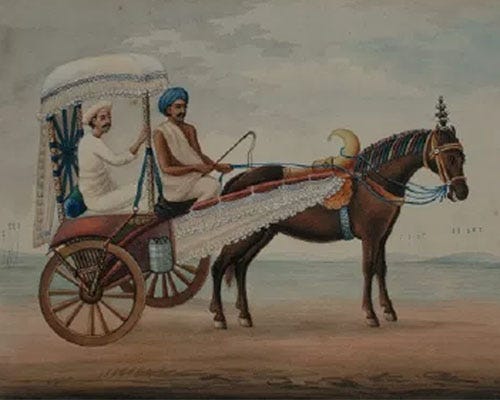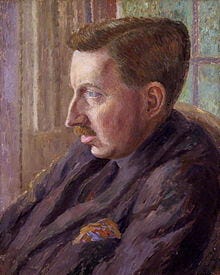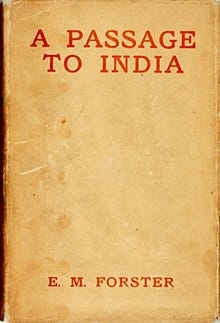Celebrating a literary centenary: A Passage to India
The opening of E.M. Forster's visionary novel evokes the setting of the novel and readies readers for the intricate plot to come...
from E.M. Forster, A Passage to India
Except for the Marabar Caves—and they are twenty miles off—the city of Chandrapore presents nothing extraordinary. Edged rather than washed by the river Ganges, it trails for a couple of miles along the bank, scarcely distinguishable from the rubbish it deposits so freely. There are no bathing-steps on the river front, as the Ganges happens not to be holy here; indeed there is no river front, and bazaars shut out the wide and shifting panorama of the stream. The streets are mean, the temples ineffective, and though a few fine houses exist they are hidden away in gardens or down alleys whose filth deters all but the invited guest. Chandrapore was never large or beautiful, but two hundred years ago it lay on the road between Upper India, then imperial, and the sea, and the fine houses date from that period. The zest for decoration stopped in the eighteenth century, nor was it ever democratic. There is no painting and scarcely any carving in the bazaars. The very wood seems made of mud, the inhabitants of mud moving. So abased, so monotonous is everything that meets the eye, that when the Ganges comes down it might be expected to wash the excrescence back into the soil. Houses do fall, people are drowned and left rotting, but the general outline of the town persists, swelling here, shrinking there, like some low but indestructible form of life.

Inland, the prospect alters. There is an Oval Maidan, and a long sallow hospital. Houses belonging to Eurasians stand on the high ground by the railway station. Beyond the railway—which runs parallel to the river—the land sinks, then rises again rather steeply. On the second rise is laid out the little civil station, and viewed hence Chandrapore appears to be a totally different place. It is a city of gardens. It is no city, but a forest sparsely scattered with huts. It is a tropical pleasaunce washed by a noble river. The toddy palms and neem trees and mangoes and pepul that were hidden behind the bazaars now become visible and in their turn hide the bazaars. They rise from the gardens where ancient tanks nourish them, they burst out of stifling purlieus and unconsidered temples. Seeking light and air, and endowed with more strength than man or his works, they soar above the lower deposit to greet one another with branches and beckoning leaves, and to build a city for the birds. Especially after the rains do they screen what passes below, but at all times, even when scorched or leafless, they glorify the city to the English people who inhabit the rise, so that new-comers cannot believe it to be as meagre as it is described, and have to be driven down to acquire disillusionment. As for the civil station itself, it provokes no emotion. It charms not, neither does it repel. It is sensibly planned, with a red-brick club on its brow, and farther back a grocer’s and a cemetery, and the bungalows are disposed along roads that intersect at right angles. It has nothing hideous in it, and only the view is beautiful; it shares nothing with the city except the overarching sky.
The sky too has its changes, but they are less marked than those of the vegetation and the river. Clouds map it up at times, but it is normally a dome of blending tints, and the main tint blue. By day the blue will pale down into white where it touches the white of the land, after sunset it has a new circumference—orange, melting upwards into tenderest purple. But the core of blue persists, and so it is by night. Then the stars hang like lamps from the immense vault. The distance between the vault and them is as nothing to the distance behind them, and that farther distance, though beyond colour, last freed itself from blue.
The sky settles everything—not only climates and seasons but when the earth shall be beautiful. By herself she can do little—only feeble outbursts of flowers. But when the sky chooses, glory can rain into the Chandrapore bazaars or a benediction pass from horizon to horizon. The sky can do this because it is so strong and so enormous. Strength comes from the sun, infused in it daily, size from the prostrate earth. No mountains infringe on the curve. League after league the earth lies flat, heaves a little, is flat again. Only in the south, where a group of fists and fingers are thrust up through the soil, is the endless expanse interrupted. These fists and fingers are the Marabar Hills, containing the extraordinary caves.
What we love about this passage…
‘Extraordinary’— the passage begins and ends with an emphasis on this word. Firstly, in its description of Chandrapore as very much not extraordinary; and finally in its description of the Marabar Caves as very much so. The passage moves literally from the mundane to the sublime in its geography — from the unattractive, unremarkable little outpost of Chandrapore to the magical caves nearby.
Despite what may seem to be almost an objective statement of what is and what isn’t idyllic in this scene, the narrator is also subtly asking us not to trust these appearances. Chandrapore, he writes, only seems to be a derelict little place when seen on foot, but if we were to gaze down on it from a mountain, it would magically transform into the picturesque, like a postcard one might buy at a souvenir shop.
Throughout the novel this idea of the way in which different views can produce different realities becomes a central, ethical concern of the novel. As the English and Indian characters begin to interact, we are asked whether their views of things can be compatible; or whether their misunderstandings will create tragedy.
About the Author

E.M. Forster (1879-1970) is best remembered for his novels A Room with a View (1908), Howards End (1910), and A Passage to India (1924). He also wrote a number of well-loved short stories, including the sci-fi classic ‘The Machine Stops’ (1909) which seems uncannily prescient in imagining human alienation from nature. He also wrote influential essays, including one on the concept of character, and gave radio broadcasts, created an opera, and wrote the classic gay novel Maurice—which he originally wrote in 1913 but which was only published after his death given the personal and political risks of explicitly writing about homosexuality. Above all, his work rests on the idea of finding sympathy across borders — as summed up in a well-known phrase from Howards End, ‘Only connect!’
To Read Alongside…
Chandrapore and the Marabar Hills are fictional places inspired by Forster’s actual visits to India. Forster also supported the careers of a number of Indian novelists who wrote about their own homeland, including Mulk Raj Anand (1905-2004), who was at one time called the Charles Dickens of India. One of his best-known novels, Untouchable (1935), deals with many of the same themes as Forster, including caste and empire.
Forster’s novel takes its title from Walt Whitman’s 1871 poetry collection Passage to India, subsequently incorporated into Leaves of Grass (1881). An excerpt from it reads:
Passage to India! Lo, soul! seest thou not God’s purpose from the first? The earth to be spann’d, connected by network, The races, neighbors, to marry and be given in marriage, The oceans to be cross’d, the distant brought near, The lands to be welded together.
Like Forster’s work, Whitman’s poem celebrates forms of connection—marriage, welding together, the distant brought near—over dissolution.
Suggest a LitHit!
Tell us your own favourites from literature you've read, and we can feature you as a Guest Curator if you like. Just email us with the following information:
Your full name
The title of the book you're suggesting
The location of the excerpt within the book (e.g., "in the middle of chapter 5"), or the excerpt itself copied into the email or attached to it (in Word)
Why you love it, in just a few sentences
About LitHits
LitHits helps you make time for reading by bringing you unabridged excerpts from brilliant literature that you can read on the go, anytime or any place. Our curators carefully select and frame each excerpt so that you can dive right in. We are more than a book recommendation site: we connect you with a powerful, enduring piece of literature, served directly to your mobile phone, tablet or computer.
Today's guest curator...
Dr Daniel Abdalla is a core member of LitHits and an expert in nineteenth and twentieth-century literature, particularly its relationship to science.
You might also enjoy...
Feedback
We'd love to hear your thoughts on our newsletter:
kshepherdb@yahoo.co.uk
Graphic design by Sara Azmy
All curation content © 2024 LitHits. All rights reserved.




